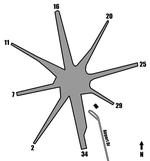Ladera Golf Course
1980 establishments in New MexicoGeography of Albuquerque, New MexicoGolf clubs and courses in New Mexico
Ladera Golf Course is a municipal golf facility in owned by the city of Albuquerque, New Mexico. It is located on the West Mesa of Albuquerque and was opened in 1980.Ladera includes an 18-hole golf course, a 9-hole executive course, a driving range, practice putting greens, and four lakes.Measuring 7,107 yards from the longest tees, Ladera has the longest playing yardage of any municipal course in Albuquerque.
Excerpt from the Wikipedia article Ladera Golf Course (License: CC BY-SA 3.0, Authors).Ladera Golf Course
Ladera Drive Northwest, Albuquerque
Geographical coordinates (GPS) Address Phone number Website Nearby Places Show on map
Geographical coordinates (GPS)
| Latitude | Longitude |
|---|---|
| N 35.1204 ° | E -106.7124 ° |
Address
Ladera Golf Course
Ladera Drive Northwest 3401
87120 Albuquerque
New Mexico, United States
Open on Google Maps






